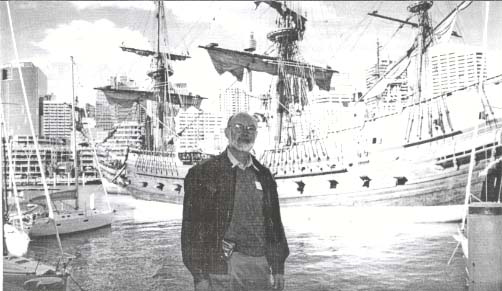 |
FAMOUS SHIPS |
 |
FAMOUS SHIPS |
The Batavia
This is really the story of two ships - both with the same name and built in the same country. The original ship was built for the Dutch United East India Company in 1628. In 1619 under the aggressive Dutch United East India Company (VOC) Governor General Jan Coen, the Dutch forced the Portuguese out of Java. Jayakerta, the capitol of the Sultan of Bantam, was captured and razed. Coen built a fortress here and named it Batavia after the Germanic Batavia tribe which had lived around present-day Leiden in the first century AD. The Dutch compared their own revolt against Spain in the 80 Years War(1568-1648)with the Batavians' fearless rebellion against Roman rule. For the next three centuries Batavia - present day Jakarta, capital of Indonesia - was the center of Dutch influence in the region.
The fort was a heavily fortified stronghold with a warehouse, armoury, and administrative center. However, it lacked a suitably imposing gate house. The VOC had one designed and prefabricated in the Netherlands, and its disassembled sandstone blocks were packed as ballast in the hold of the brand-new ship BATAVIA.
The original BATAVIA was probably built in Amsterdam’s massive Oostenburg shipyard. These large ships were ocean going vessels called retourships. The exact dimensions of the original BATAVIA are not fully known, but the dimensions of the full size replica - the second BATAVIA, along with other interesting facts, is known. Her overall length is 193 ft 6 in.; beam 34 ft 5 in.; draught, 16 ft 9 in.; length of keel, 121 feet 5 in.; height of mainmast from keel, 180 ft 5 in.; height of mizzenmast, 91 feet 10 in.; height of foremast, 141 ft. 1 in.; weight before ballasting, 650 tons. The idea to build the replica of the BATAVIA was born by William Vos. This was about the same time (1970's) that the Western Australian Maritime Museum was examining the wreck of the first BATAVIA. To make a long story short, the BATAVIA was again built, starting in 1985 with actual construction. The Mayor of Lelystad, on the shores of the Markenneer, gave land for the project and Batavia-werf was founded. It is located on reclaimed @ that once was the bottom of an inland sea known as the Zuidersee. The yard itself is located on what used to be the 'Eastward passage', transited by ocean-going vessels on their way to far-off places. The first BATAVIA took seven months to build with a force of 300 men. The second BATAVIA took 10 years to build with a force of 60 men and women.
The story of the
short and tragic life of the first BATAVIA is written in several books, one of
which is The First and Last Voyage of the Batavia by Phillip Godard. Basically,
it was the case of poor judgment by the captain, Jacobsz, resulting from
miscalculation and probably drunkenness. This led to the BATAVIA hitting a reef
off the coast of Australia and slowly breaking up. In the ensuing mayhem 40
drowned, the hold was looted of wine, ale and other spirits. Some 200 survivors
made it to shore eventually onto the barren, uninhabited Abrolhos Islands. The
leader, Pelsaert, took the ship's sloop and when in search of aid, which
eventually led him to Batavia, 900 miles away.
In the mean time, a revolt was brewing among the remaining survivors. A senior VOC official, Comelisz, seized control. He had plans to murder many of the survivors, steal the relief ship when it came, and go pirating. Sending the soldiers away to another island to ‘look for water’, Comelisz and forty of his followers proceeded to murder 96 people and take the women as concubines. He then attacked the soldiers but the soldiers were forwarned and beat the attack off. Meanwhile, Pelsaert came back from Batavia with the rescue party. Luckily, the soldiers were able to warn him of the plot to seize his ship, and he was able to defeat the rebels and bring those to justice who bad committed this terrible crime. In Cornelis' case, he lost both hands chopped off and was the first to hang joining seven of his chief mutineers.
Many of the items that the BATAVIA carried were recovered by Pelsaert, some of which can be seen in the National Maritime Museum in Sydney and the Western Australia Maritime Museum.
The second BATAVIA, as indicated above, was constructed over 10 years. She arrived at Sydney harbor in December, 1999. She was transported to Australia for the 2000 Olympics and arrived piggyback on a semi-submersible dock ship. This was required due to the fact that this BATAVIA had very few concessions to modern safety regulations - she has no modern navigational aids (radar), no engine to help with the sailing of the ship, etc.
It was a real treat to go aboard this ship and observe the interior of the ship ahnost exactly like the ship that sailed for the Dutch in 1629. The ship was constructed using authentic Dutch treatises on shipbuilding for that century - Nicholas Witsen’s volume of 1671 and Cornelis van Yk’s multi-volume work of 1697. Even the actual Dutch wreck of the first BATAVIA was used along with information gathered from the VASA Museum. She can be seen today at the National Maritime Museum in Sydney, Australia and will be there through the 2000 Olympics, which are being held in Sydney. The picture that is part of this article is worth more words than I have than to write.